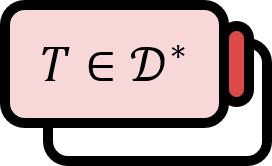Translation of Distributions
Buildup
Distribution cannot be translated in the same manner as functions defined on the real space because their domain is a function space. However, for regular distributions, there is a corresponding locally integrable function $u\in L_{\mathrm{loc}}^{1}$, which can be represented as follows.
$$ T_{u}(\phi) =\int u(x)\phi (x) dx,\quad \phi \in \mathcal{D}(\mathbb{R}^{n}) $$
Thus, some action $S$ on $u$ would yield $Su=u^{\prime}$, and if $u^{\prime}$ is still a locally integrable function, then there exists a corresponding distribution $T_{u^{\prime}}$. Therefore, we consider the action $S$ on $u$ as if it were the action on $T_{u}$. The idea is to extend this to the entire set of distributions to define the translation of distributions.
Let us assume that $u\in L_{\mathrm{loc}}^{1}$ and its corresponding regular distribution $T_{u}$ are given. Although we use $T$ as the symbol for translation, since $T$ is already used as a symbol for distributions, we take the shifting $S$ and call the translation of $a\in \mathbb{R}$ as $S_{a}$. And we call the translation of $u$ as $u^{\prime}(x)=(S_{a}u)(x)=u(x-a)$. Then, it still holds that $u^{\prime} \in L_{\mathrm{loc}}^{1}$. Hence, a corresponding regular distribution $T_{u^{\prime}}$ for $u^{\prime}$ exists and it is as follows for $\phi \in \mathcal{D}(\mathbb{R}^{n})$.
$$ \begin{align*} T_{u^{\prime}}(\phi)&=\int u^{\prime}(x)\phi (x)dx \\ &= \int u(x-a)\phi (x)dx \\ &=\int u(x)\phi (x+a)dx \\ &= \int u(x) S_{-a}\phi (x) dx \\ &=T_{u}(S_{-a}\phi) \end{align*} $$
Test functions $\phi$ remain test functions even after translation, so there are no issues with the above calculation. Therefore, we can understand translating $T$ as translating $u$ symmetrically. Additionally, it can be understood that it has the same effect as translating the test functions in the opposite direction symmetrically.
Definition1
The translation of a distribution $T$ is defined as below.
$$ (S_{a}T)(\phi):=T(S_{-a}\phi) $$
Gerald B. Folland, Fourier Analysis and Its Applications (1992), p310 ↩︎
